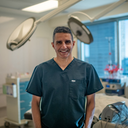105lbs 5"5'. First BA in April of 07' I had elected to go with 350cc saline through the belly button, the results were beautiful for about 8 months when I noticed hardening of the right breast.It was obvious that I had a capsulor contractor. After the second surgery in April 09 We replaced both implants with cohesive gel silicon 500cc with capsulectomy done on the right breast. Then in December 09' had to revise the left breast that had bottomed out. Now 4 months later im not sure if it is bottoming out again or another capsuler contractor or both!
Answers (13)
From board-certified doctors and trusted medical professionals
Dr. Brooke R. Seckel, MD, FACS (retired)
Board Certified Plastic Surgeon
Answer
More Breast Implant Revision Questions
See all Breast Implant Revision Q&AWE SEND PRETTY
EMAILS
What’s trending? Who’s turning heads? Which TikTok myths need busting? We’ve got you. No fluff, no gatekeeping—just real talk. Get our free, unfiltered newsletter.




